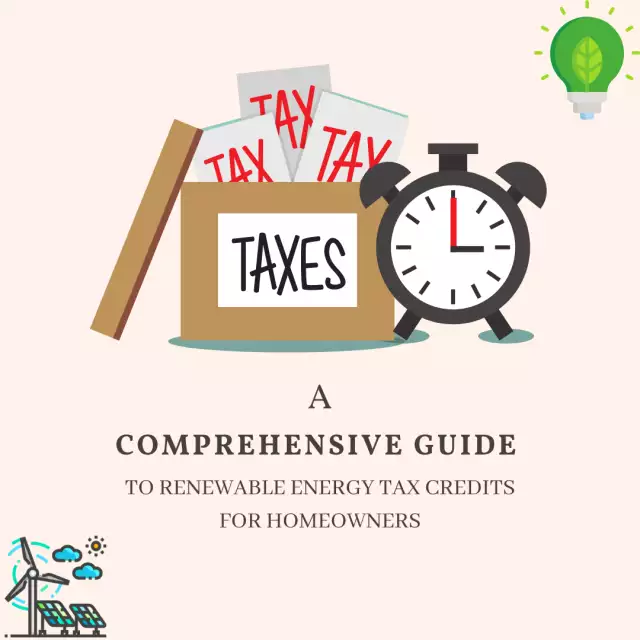A Comprehensive Guide to Renewable Energy Tax Credits for Homeowners
A Comprehensive Guide to Renewable Energy Tax Credits for Homeowners
Renewable Energy Tax Credits are incentives offered by the federal government to homeownerswho install renewable energy systems in their homes. The credit reduces the amount of taxes you owe and can even lead to a refund if the credit exceeds your tax liability. This guide will provide you with a comprehensive overview of Renewable Energy Tax Credits for homeowners.
What is a Renewable Energy Tax Credit?
Renewable Energy Tax Credits are incentives offered by the federal government to homeowners who install renewable energy systems in their homes. The credits are designed to encourage homeowners to switch to renewable energy sources to reduce their carbon footprint and promote energy independence. The credits are a dollar-for-dollar reduction in the amount of federal income taxes owed, and in some cases, can even lead to a refund if the credit exceeds your tax liability.
What do Renewable Energy Systems qualify for Tax Credits?
To qualify for the Renewable Energy Tax Credit, the following renewable energy systems must be installed in your primary residence:
- Solar Energy Systems: Solar panels that generate electricity or heat water for use in your home qualify for the tax credit.
- Wind Energy Systems: Residential wind turbines that generate electricity for use in your home qualify for the tax credit.
- Geothermal Heat Pumps: Geothermal heat pumps that use the ground or groundwater as a heat source or sink to heat or cool your home qualify for the tax credit.
- Fuel Cell Systems: Fuel cell systems that convert fuel into electricity through a chemical reaction qualify for the tax credit.
What are the Eligibility Requirements for the Renewable Energy Tax Credit?
To be eligible for the Renewable Energy Tax Credit, the following requirements must be met:
- You must be the owner of the renewable energy system.
- The renewable energy system must be installed in your primary residence.
- The renewable energy system must be new or if it's an existing system, it must be modified or improved.
- The renewable energy system must meet all applicable performance and safety standards.
What is the Amount of the Tax Credit?
The amount of the Renewable Energy Tax Credit varies depending on the type of renewable energy system installed. The following are the tax credit percentages for each system:
- Solar Energy Systems: 26% through the end of 2022, 22% in 2023.
- Wind Energy Systems: 26% through the end of 2022, 22% in 2023.
- Geothermal Heat Pumps: 26% through the end of 2022, 22% in 2023.
- Fuel Cell Systems: 26% through the end of 2022, 22% in 2023.
The tax credit is applied to the cost of the renewable energy system, including labor and installation fees. There is no limit to the amount of the tax credit for solar, wind, and geothermal systems, but there is a limit of $1,000 per kilowatt for fuel cell systems.
How Do You Claim the Tax Credit?
To claim the Renewable Energy Tax Credit, you must complete and file IRSForm 5695 with your federal income tax return. You will also need to attach a copy of the Manufacturer's Certification Statement, which is a document provided by the manufacturer that certifies that the system meets the eligibility requirements for the tax credit.
The Benefits of Renewable Energy Tax Credits
There are several benefits of installing renewable energy systems in your home and taking advantage of the Renewable Energy Tax Credit. Some of the benefits include:
- Lower Energy Bills: By generating your own energy, you can reduce your reliance on the grid and lower your energy bills.
- Increased Home Value: Homes with renewable energy systems installed typically have a higher resale value than homes without them.
- Environmental Benefits: By switching to renewable energy, you can reduce your carbon footprint and contribute to a cleaner environment.
- Tax Savings: The tax credit can help reduce your federal income tax liability and even lead to a refund if the credit exceeds your tax liability.
Maximizing Your Tax Credit
To maximize your tax credit, it's important to understand the eligibility requirements and the documentation needed to claim the credit. The following tips can help you make the most of your Renewable Energy Tax Credit:
- Keep Detailed Records: Keep all documentation related to the installation of your renewable energy system, including receipts, invoices, and contracts. These documents will help you calculate the total cost of the system and the labor and installation fees.
- Get a Manufacturer's Certification Statement: To claim the tax credit, you must attach a Manufacturer's Certification Statement to your tax return. This document is provided by the manufacturer and certifies that the system meets the eligibility requirements for the tax credit.
- Claim the Credit in the Right Year: The tax credit is claimed in the year the system is installed, even if the system was not operational for the entire year. Be sure to claim the credit in the year the system was installed to maximize your tax savings.
- Consult with a Tax Professional: Tax laws and regulations can be complex, so it's always a good idea to consult with a tax professional to ensure that you are maximizing your tax credit and complying with all IRS requirements.
Conclusion
Renewable Energy Tax Credits are a great incentive for homeowners to switch to renewable energy and reduce their carbon footprint. By installing solar panels, wind turbines, geothermal heat pumps, or fuel cell systems in your primary residence, you can take advantage of the tax credit and enjoy the benefits of clean energy. Be sure to consult with a tax professional for more information on how to claim the tax credit and how it can impact your overall tax liability.








